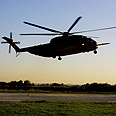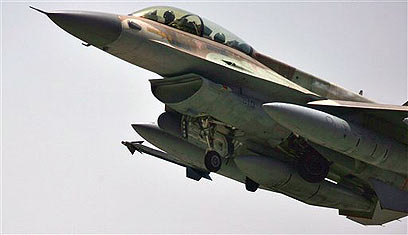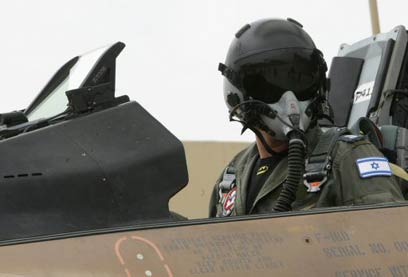
IDF helicopter
צילום: שאול גולן
Preparing for future wars
Romania chopper crash provids glimpse into Israeli preparations for strategic, long-range ops
Ynetnews feature: Israel Air Force deployments in various European states are always classified. The host country never knows what hides behind the training sessions held in its territory. Such sessions may take place in Hungary, Romania, Greece, Italy, Germany, Canada, and certainly in the US. In most cases, these training sessions do not include joint drills between Israel's Air Force and the hosting Air Force; rather, the host country provides our Air Force with a training platform for two weeks or longer.
While the host country always deploys observers and participates in joint briefings, no details hinting to an operational Israeli plan are ever revealed the exercise model or the flight profile. Israel also does not use classified weapons and special electronic warfare means that could hint to our intentions or capabilities.
The recent helicopter crash in Romania drew attention to the Air Force's activity in the country, yet beyond that, it exposed the fact that heavy transport choppers are an inseparable part of the Air Force's strategic, long-range doctrine. Until now, foreign reports focused on training sessions held by fighter jets that were reportedly meant to prepare us for a possible Iran strike. The helicopters somehow remained in the shadows, yet the Romania disaster brought them to light.
_wa.jpg)
Israeli chopper heading to Gaza (Photo: Eli Elgarat)
The Israeli helicopters were not dismantled and sent to Romania to be reassembled. They flew there, navigating through thousands of kilometers and unfamiliar routes while refueling in midair. The equipment needed for the Romania deployment apparently arrived on board Hercules planes, which can also transport gunships. If you connect the dots, you get a potential deployment aimed at special commando operations deep in enemy territory.
If you also take note of the ground crews deployed in the field and Israeli controllers cooperating with local control tower officials, you get a force that can theoretically embark on a significant military operation from a foreign airport, or carry out a rescue operation of Israeli forces or pilots far away from Israel.
Painful American lesson
In order to understand why Israeli choppers fly all the way to Romania for training, we would do well to take a glimpse into the past - April 25, 1980 was one of the low points in the US military's history. Special Forces transported by air embarked on an operation meant to secure the release of American hostages in Iran. Months of planning and training matured into a highly complex operation – the main problem was crossing large distances under unfamiliar conditions, while using improvised landing sites.Yet the lengthy training sessions proved futile when pilots discovered that what was happening in real-time was nothing like what they prepared for. This prompted a withdrawal, improvisation, and disaster. The Americans ended up leaving behind whole planes (both intact and burned out) in the Iranian desert; eight airmen were killed in the operation, which failed before it even started.
Now, the Air Force is flying to Romania so this won't happen to us too.
Crafting operational plans and practicing future flights is insufficient. The skills required for such operations are acquired through hundreds and thousands of long-range training flights under real-life conditions, while facing diverse weather conditions that may not be familiar in the Middle East.

Israeli fighter jet takes off (Photo: AP)
Our new generation of pilots is being trained differently and thinks differently. We are no longer talking about domestic flights or south Lebanon sorties. It's a whole new ballgame. A flight plan for a range of thousands of kilometers is wholly different than the preparations needed for flying in the "old wars": Communication procedures, fuel and logistics, routes, altitudes, and flight speed. The contingencies are wholly different as well: There's a huge difference between rescuing a pilot from the shores of Beirut and from a site located thousands of kilometers away.
In the mid-1990s, the Air Force embarked on organizational and mental changes in order to shift from being a tactical force to becoming a strategic one that operates in broad theaters. Yet this cannot be done alone. In September 2007, according to foreign reports, Israeli jets struck a nuclear reactor in the Syrian desert. Needless to say, the jets that carried out the operation would not pass through the skies of a political and military power like Turkey secretly and with no interference in the absence of close ties with Ankara.
As opposed to common perception, Israel's Air Force deployments in Turkey were not terminated in the past two or three years because of deteriorating ties between the two states. The Air Force itself concluded that it exhausted all benefits inherent in the Turkish training sessions. Turkey was attractive for the Air Force as long as it developed no ties with other states that allowed us to engage in training sessions at longer ranges more commensurate with Air Force combat scenarios.
At this time, Italy, Romania, Germany, Greece, and the US allow our Air Force to engage in more realistic training sessions ahead of future threats; the reports about the termination of training flights in Turkey in the wake of Operation Cast Lead or the flotilla incident are yet another Mideastern myth.
Opening up to the world
Until the 1990s, our Air Force was reclusive. After the Six-Day War and during the War of Attrition, the Americans were wooing us; they sold us military equipment, but we were very secretive and shied away from sharing information with them, even though they were eager for it because of the war in Vietnam. For example, the Americans wanted to learn how we contend with Soviet equipment and doctrine. At one point, when they received films of Israeli Air Force battles, they viewed it as a priceless achievement.Meanwhile, Israeli pilots who headed to the US to train on flying new aircraft felt the Americans were trying to get information out of them. Israeli pilots were invited to teach advanced courses in the hopes the US can learn something from them. Yet our brave heroes did not fall into the trap: The Air Force, just like the whole IDF, believed that secrets shared with foreign states will end up being leaked to our enemies. Besides, Israel required the help of no foreign country in order to defend itself. The strike on Iraq's nuclear reactor in 1981 was a one-time event that did not reflect a change in the Air Force's doctrine.

New generation of Israeli pilots (Photo: Reuters)
However, in the 1990s a broader, more regional mode of thinking emerged: How do we cross hostile states? It was clear to everyone that the rules of the game had changed and that we must cooperate with friendly Air Forces in the region. Israel started to shift closer to the US and aimed to break the ice. In the early 1990s, the US Air force was invited to take apart in joint tactical exercises here.
In 1993 we also experienced a diplomatic revolution that opened Israel to the world: The Oslo Accords. The commanders of Air Forces in Europe, in the Middle East, and in the Far East (for example, in India) started to tighten their ties with Israel. When the Air Force held its jubilee celebrations in 1998, the commanders of 20 foreign Air Forces arrived here to take part in the festivities. Ties with Turkey hit a zenith, while Israel learned to let go of its paranoia and realized that it's possible to fly through the airspace of foreigners without exposing secrets.
We also learned that by sharing professional information with a friendly state we get something in return: In the process, we learned to use the same language while talking to NATO armies and other militaries. This helped in forming coordination mechanisms, sharing knowledge, and resolving problems. By now, the Americans and Canadians allow Air Force aircraft to fly directly to the US in order to hold joint drills at their most sophisticated, classified facilities.
All Air Force commanders in the past two decades have taken the path of greater openness to friendly Air Forces. Israel has drawn priceless benefits from this in terms of training sessions vital for future wars. The accident in Romania must not curb this trend.










